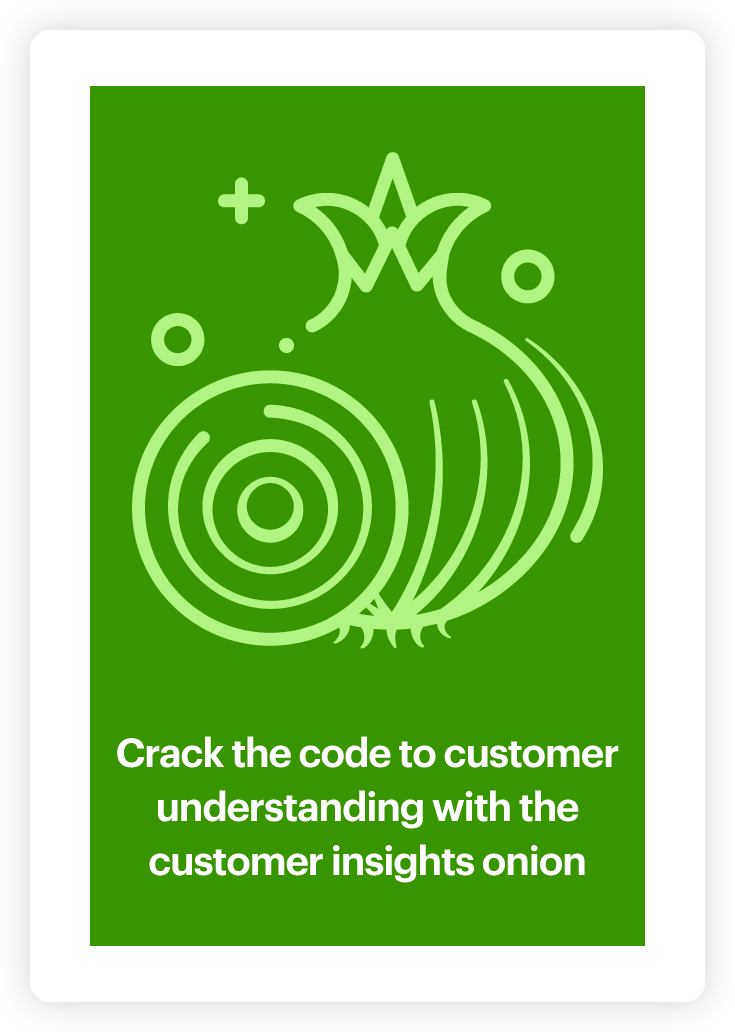A 3-step customer insights framework to support your insight strategy

Every company wants to better understand their customers, but not everybody has an overarching customer insights strategy or framework in place that allows them to do so. Our three-step customer insights framework is being used by customer insight teams to take a systematic approach to developing robust understandings of their customers.
If you’re reading this article you might be wondering: What do you mean by consumer insights? Customer insight is generally understood as the process of generating actionable intelligence from customer data. Consumer insights research usually involves analyzing some combination of customer feedback (e.g. survey responses, online reviews) and behavioral customer data (e.g. sales figures, purchase behavior). This in turn helps you understand consumers’ attitudes toward a range of relevant topics and behavioral trends to inform product development, marketing strategy and other strategic business decisions.
What is customer insight strategy?
Customer insight strategy can be thought of as your ultimate guidebook for generating and analyzing customer data and using the resulting insights to drive action and decision-making within your organization. A strategy will help you take a coherent, robust and overarching approach to learning about your customers and putting them at the forefront of decision-making. In other words: If you’re just being reactive to stakeholder briefs, you don’t have a consumer insights framework or strategy in place.
How do you develop a customer insight strategy?
Loyal customers are the heartbeat of any business’s success. The digital age has empowered customers by connecting them with an endless number of choices, making it harder to drive customer loyalty. With this in mind, the key to any business’s success is putting consumer insights at the forefront of your product plan, customer service operations and other strategic decisions.
Any successful customer insight strategy or customer insights framework requires a competent customer insights team dedicated to equipping the wider organization with business intelligence rooted in consumer research and analytics. Evidently, insights alone won’t help your business unless they are communicated effectively with your stakeholders and followed up by actions.
Once you have asked the right questions, collected useful data and analyzed your data, the next step is to create a coherent narrative that articulates what the data is telling you along with the implications and possible actions for your organization. To achieve this, you should ask yourself the following questions:
- Who in the organization would be interested in these insights?
- What could these stakeholders do with these customer insights?
- Why do these insights matter?
- What are some possible actions we could take based on these insights?
By identifying and articulating the who, what, why, and what’s next in your insights, your analysis can tell a complete story that inspires stakeholders to take actions that stimulate growth .
Why is customer insight important?
To put it simply, customers pay the bills. So knowing what makes them happy (and unhappy) is essential to keeping the lights on.
Adopting a customer insights framework can help you eliminate the guesswork and trial and error process and make truly customer-centric decisions based on consumer insight research. By making these customer-centric decisions your business or brand will be able to:
- Pinpoint the drivers of customer satisfaction
- Personalize communications in line with the different segments of your audience
- Focus on what customers like about your product or service in your marketing communications
- Decrease customer churn
- Increase customer lifetime value
- Uncover the strengths and weaknesses of your brand, product or service and act upon them
How do you gain customer insights and develop your customer insights framework?
In order to generate valuable consumer insights and inform all the different components of your customer insights framework, you need high-quality, representative data. There are a number of different data sources your business can use, including:
- Customer surveys (including NPS and CSAT)
- Online reviews
- Customer service transcripts
- Social media conversations
- Online forums
You should always have at least one or even multiple business goals in mind to inform your consumer insights framework. An overarching customer insights strategy might involve an increase in sales, an expansion to a new market, or improving customers’ perception of your brand.
If you choose to conduct a customer feedback survey, it is paramount that you keep your overall business objective in mind, when generating your questions. Ideally, surveys should be comprised of structured questions, as well as qualitative open-ended questions.
Structured questions with yes/no answers, multiple choice, or a rating scale will provide you with the data you need to segment responses based on demographic attributes, buying behavior, satisfaction ratings and other relevant attributes. Qualitative open-end responses, on the other hand, give respondents the room to express their opinions in their own words. Qualitative questions provide the detail and reasoning that structured prompts can’t. Layering the two will provide you with the basis to extract all the rich customer insights you are looking for.
In case you are seeking to improve your customer service interactions an example of a closed and an open-ended question pair might be:
- On a scale of 1 to 10 how satisfied are you with your recent customer service interaction?
- How can we improve your customer experience?
In that sense, it is helpful to think of a customer insights framework as a three-layered onion. The top layer consists of relevant topics your customers are speaking about, the middle layer is your competitors and the inner layer is your own brand or business:
1) Your brand/business:
Loyal customers are the lifeblood of any successful business. By recognizing opportunities and worrisome trends concerning your brand, products, or services, you can amplify what customers love and work on aspects of your products or services that are in need of improvement.
It is likely that you’ve already established feedback channels that enable customers to tell you what they like and dislike about your products, services, and your brand as such. Examples of such channels and data sources are customer service transcripts, social media conversations, online reviews, or customer survey open-ends that are attached to an NPS or CSAT score.
2) Your competitors:
Brand loyalty is an increasingly fickle concept, which is why marketers need to objectively analyze what consumers are saying about your brand vs. your competitors to make effective customer-centric business decisions and gain an edge over the competition.
Keep a pulse on your competitors by discovering points of differentiation and similarity to inform marketing, customer service, and campaign strategies as well as product development priorities. Online reviews and social media conversations are publicly available for your analysis and will help you generate the necessary consumer insights to support this layer of your customer insight strategy.
3) Relevant topics:
Learn everything you need to know about the broader context in which your customers and target audiences are making purchasing decisions by analyzing conversations around topics relevant to your business. People discuss every possible topic you could think of on social media and in online forums, which is why your insights team should make use of social listening tools to gather and analyze conversations around topics that are relevant to your brand and your business objectives.
The customer insights onion framework provides marketers and customer research teams with a comprehensive approach to truly understanding target audiences. Only by carefully considering all three layers of the onion will you be able to truly understand your customers.
Ready to put the customer insights onion to work in your organization? Download our customer insights framework and template or book a no-commitment discovery call!
